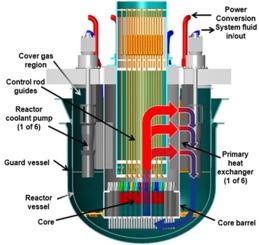当前位置:
X-MOL 学术
›
Prog. Nucl. Energy
›
论文详情
Our official English website, www.x-mol.net, welcomes your feedback! (Note: you will need to create a separate account there.)
Development of phenomena identification and ranking table for Westinghouse lead fast reactor's safety
Progress in Nuclear Energy ( IF 2.7 ) Pub Date : 2021-01-01 , DOI: 10.1016/j.pnucene.2020.103577 Jun Liao , Paolo Ferroni , Richard F. Wright , Uriel Bachrach , James H. Scobel , Tanju Sofu , Adrian M. Tentner , Sung Jin Lee , Michael Epstein , Michele Frignani , Mariano Tarantino
Progress in Nuclear Energy ( IF 2.7 ) Pub Date : 2021-01-01 , DOI: 10.1016/j.pnucene.2020.103577 Jun Liao , Paolo Ferroni , Richard F. Wright , Uriel Bachrach , James H. Scobel , Tanju Sofu , Adrian M. Tentner , Sung Jin Lee , Michael Epstein , Michele Frignani , Mariano Tarantino

|
Abstract The Westinghouse Lead-cooled Fast Reactor (LFR) is a medium-size, passively safe, economic, Gen-IV nuclear reactor. An important effort within the Westinghouse LFR program is the development of the safety analysis methodology, which comprises computer code development, model development, and experimental testing. A key initial task associated with the development of the safety analysis methodology is the identification of processes and phenomena that affect the plant's capability to meet selected safety performance indicators. This is accomplished through the development of a Phenomena Identification and Ranking Table (PIRT) for selected accident scenarios which, for this specific PIRT effort, included selected postulated design basis accidents and hypothetical beyond design basis accidents in LFRs. This paper describes the role of PIRT in the development of the Westinghouse LFR safety analysis methodology and the process used in the PIRT development. Specifically, the Westinghouse LFR PIRT assessed importance of pertinent phenomena and identified gaps in their knowledge-base by evaluating current modeling capabilities and data available for validation. The ultimate goal was to provide guidance on computer code development and validation efforts and to prioritize testing to support LFR design and licensing. The key phenomena and processes that are deemed highly important for the safety performance indicators, but for which the state of knowledge is low, are presented. The testing program and analyses development are planned to address significant phenomena in the PIRT.
中文翻译:

西屋铅快堆安全现象识别排序表的研制
摘要 西屋铅冷快堆 (LFR) 是一种中型、被动安全、经济的第四代核反应堆。西屋 LFR 计划中的一项重要工作是开发安全分析方法,包括计算机代码开发、模型开发和实验测试。与开发安全分析方法相关的一项关键初始任务是识别影响电厂满足选定安全绩效指标的能力的过程和现象。这是通过为选定的事故情景开发现象识别和排名表 (PIRT) 来实现的,对于这一特定的 PIRT 工作,其中包括选定的假设设计基准事故和 LFR 中的假设超出设计基准事故。本文描述了 PIRT 在西屋 LFR 安全分析方法开发中的作用以及 PIRT 开发中使用的过程。具体来说,西屋 LFR PIRT 评估了相关现象的重要性,并通过评估当前的建模能力和可用于验证的数据来确定其知识库中的差距。最终目标是为计算机代码开发和验证工作提供指导,并优先测试以支持 LFR 设计和许可。介绍了被认为对安全绩效指标非常重要但知识水平较低的关键现象和过程。测试程序和分析开发计划解决 PIRT 中的重要现象。
更新日期:2021-01-01
中文翻译:

西屋铅快堆安全现象识别排序表的研制
摘要 西屋铅冷快堆 (LFR) 是一种中型、被动安全、经济的第四代核反应堆。西屋 LFR 计划中的一项重要工作是开发安全分析方法,包括计算机代码开发、模型开发和实验测试。与开发安全分析方法相关的一项关键初始任务是识别影响电厂满足选定安全绩效指标的能力的过程和现象。这是通过为选定的事故情景开发现象识别和排名表 (PIRT) 来实现的,对于这一特定的 PIRT 工作,其中包括选定的假设设计基准事故和 LFR 中的假设超出设计基准事故。本文描述了 PIRT 在西屋 LFR 安全分析方法开发中的作用以及 PIRT 开发中使用的过程。具体来说,西屋 LFR PIRT 评估了相关现象的重要性,并通过评估当前的建模能力和可用于验证的数据来确定其知识库中的差距。最终目标是为计算机代码开发和验证工作提供指导,并优先测试以支持 LFR 设计和许可。介绍了被认为对安全绩效指标非常重要但知识水平较低的关键现象和过程。测试程序和分析开发计划解决 PIRT 中的重要现象。



























 京公网安备 11010802027423号
京公网安备 11010802027423号